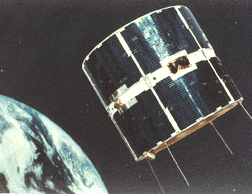Satellite Showcase
COS-B
The Mission
|
COS-B was launched on 9 August 1975 into an orbit of ~100,000 km, with a
period of 37 hours. The orbital plane was inclined at ~90 deg to the Earth's
equator. The satellite spun on its axis at a rate of ~10 rpm. Sun
and Earth sensors were used for attitude measurements from which the pointing
direction could be determined with a precision of about 0.5 deg. The timing
accuracy was 0.5 ms or better. The satellite was operated in a pointing mode
with its spin axis directed towards fixed points in the sky for periods of
four to five weeks early in the mission and up to 3 months in later
observations. In total, 64 observations (or pointings) were made. The
mission ended on 25 April 1982. |

Credit: NASA
|
The experiment consisted of a spark chamber, triggered by a scintillation
counter telescope. Beneath the telescope was an energy calorimeter which absorbed the
secondary particles produced by the incident photons. The detector could
detect gamma-rays in the energy range of 30 MeV to 4 GeV. The experiment is
described in detail by Bignami et al. (1975).
Alongside the gamma-ray detector was mounted a proportional counter,
sensitive to 2-12 keV X-rays. This detector was intended to provide
synchronization for possible short-period pulsations of gamma-ray emission
from pulsating X-ray sources. The pulsar synchronizer was also used for
monitoring the intensity of radiation from X-ray sources.
The Science Results
The scientific objectives of COS-B were to study the sources of
extra-terrestrial gamma radiation at energies above ~30 MeV. Specifically,
the mission was to
Study the spectrum and distribution of galactic gamma-rays
Determine the flux and distribution of extragalactic gamma-ray emission
Study known point sources
Search for new point sources.
The results of COS-B observations of extragalactic gamma-rays, resolved
galactic sources, gamma-ray pulsars, binary systems, large-scale galactic
emission, and localized gamma-ray sources allowed the field of gamma-ray
astronomy to move from the "discovery" phase into the "exploration" phase.
Truly, a valuable new window into our Universe had been opened.
Additional References
K. Bennett, Nuclear Physics B (Proc. Suppl) 14B (1990) 23-34.
G.F. Bignami, Space Sci. Instr. 1 (1975) 245.
Much of the information found here was condensed from "COS-B: The
Highlights" (Bennett 1990).
|
